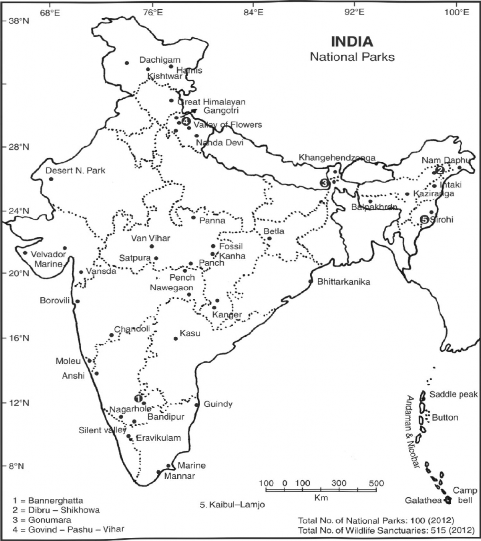WILDLIFE
India has a great diversity in its geo-climatic environment. This diversity of environment provides natural habitats for wild animals, birds and insects. Out of the world’s total of about 15 lakh species of animals, India has 81,251 or ( 6.7 percent). According to S.H. Prater (1934), India can be divided into six zoo- geographic regions. India has 350 different mammals, 1200 species of birds, 453 species of reptiles, and 45000 plant species. Moreover, India has 50,000 known species of insects, including 13,000 butterflies and moths. They are: (i) The Himalayan region (ii) The Northern Plains, (iii) The Thar Desert, (iv) The Peninsular Plateau, (v) The Malabar Coast, and (vi) The Nilgiri.
Under the pressure of a fast increasing population and heavy demand of food and industrial raw material, the forest cover of India has shrunk substantially. Moreover, the density of trees in the forests is very low as compared to the forests of other countries. Consequently, the natural habitat of wild animals are disappearing. The growing trade of furs of big cats and tiger bones has diminished their number. There is increasing demand of rhino-horns and deer musk which are used in medicines and aromatic substances. Moreover, due to the continuous hunting of wild animals and illegal poaching, the number of wild animals is decreasing day by day. Some of the species are on the verge of extinction. Asiatic lion, clouded leopard, tiger, musk-deer, rhinoceros, great Indian bustard, Nilgiri langur, python and vultures are the species in danger.
In order to conserve wildlife, the Government of India passed the Wildlife Protection Act in 1972. Large tracts in various parts of the country covering 1.56 lakh sq km—4.75% of the total area of the country—were declared as national parks, sanctuaries and biosphere reserves. At present, the number of national parks and sanctuaries has gone up to 89 and 490 respectively.
To increase the number of animals classified under endangered species, Project Tiger (1973), Crocodile Breeding Project (1975), Rhinoceros Project (1987), Snow-leopard Project, and Project Elephant (1988) have been launched.
National Park: A national park is a relatively large area of one or several ecosystems that are not being materially altered by human exploitation and occupation. Here, plant and animal species, geomorphological sites and habitats for special scientific education and recreation are preserved. The National Parks of India have been plotted in Fig. 5.5 and some of the important national parks have been described in the following section:
Wildlife Sanctuary: Similar to a national park, a wildlife sanctuary is dedicated to protect wildlife and particular species. In a sanctuary, human activities are allowed, but in a national park human interference is totally prohibited.

, n discussed in
Tiger Reserves: Some of the important Tiger Reserves of India have been subsequent pages. Their geographical distribution has been shown in Fig. • _
the
100”E
84° E
92”E
68“ E
68“E

100 0 100 200 300 400 500Km

I 1 > I I 1 1

Total No. of Tiger Reserves: 39
